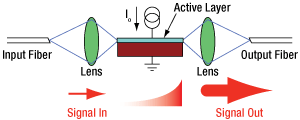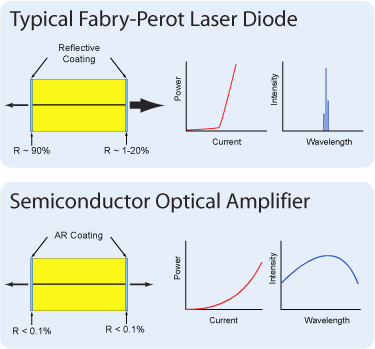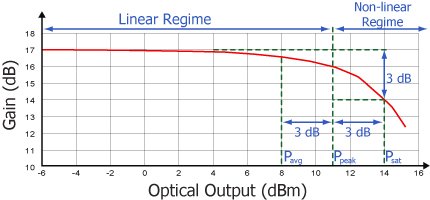Booster Optical Amplifiers (BOAs), 1700 nm

- Polarization-Dependent Booster Optical Amplifiers (BOAs)
- SM- or PM-Fiber-Pigtailed Butterfly Package
- 1700 nm Operating Wavelength
- Small Signal Gain of 28 dB
FC/APC Connectors
BOA1700P
BOA with PM Fiber and
FC/APC Connectors, Close-Up of Butterfly Package Shown
BOA1700
BOA with SM Fiber and
FC/APC Connectors

Please Wait
| Optical Amplifier Selection Guide |
|---|
| 780 - 795 nm BOAs |
| 830 nm BOAs |
| 930 nm BOAs |
| 980 nm BOAs |
| 1050 nm BOAs |
| 1210 nm BOAs |
| 1250 nm BOAs |
| O-Band (1285 - 1350 nm) BOAs |
| E-Band (1410 nm) BOAs |
| C-Band (1550 nm) BOAs and SOAs |
| L-Band (1590 - 1625 nm) BOAs |
| 1685 nm BOAs |
| 1700 nm BOAs |
Applications
- Amplifying Polarized Laser Signals Around 1700 nm
- Amplifying Widely Tunable Lasers Around 1700 nm
- Preamplifier for Telecom Applications Beyond U-Band

Click to Enlarge
When current is applied across the ridge waveguide, excited state electrons are stimulated by input light, leading to photon replication and signal gain.
Features
- Polarization Dependent: Amplifies One Polarization State
- 1.5 m Long, SM or PM Fiber Pigtails with FC/APC Connectors
- 1695 nm ASE Center Wavelength
- Small Signal Gain: 28 dB (Typical)
- Saturation Output Power: 18.5 dBm (Typical)
- 3 dB Bandwidth: 108 nm (Typical)
- Each End Face of the Semiconductor is AR Coated (R < 0.1%) to Prevent Lasing
Booster Optical Amplifiers (BOAs) are single-pass, traveling-wave amplifiers that perform well with both monochromatic and multi-wavelength signals. Since BOAs only amplify one state of polarization, they are best suited for applications where the input polarization of the light is known. Each BOA consists of a highly efficient InP Quantum Well (QW) layer structure, which is designed for amplifying polarized optical signals in the 1700 nm band and is also an ideal gain medium for implementing wide-bandwidth tunable lasers.
As seen in the schematic to the right, the input and output of the amplifier are coupled to the active layer of the ridge waveguide on the optical amplifier chip. The device is contained in a standard 14-pin butterfly package, with either single mode or polarization-maintaining fiber pigtails that are terminated with FC/APC connectors. The BOA1700 uses single-mode, non-polarization-maintaining SMF-28e fiber, while the BOA1700P uses polarization-maintaining PM15-U40D fiber with the connector key aligned to the slow axis. An integrated thermoelectric cooler (TEC) and thermistor allow these BOAs to be temperature controlled, thus stabilizing the gain and the spectrum.
For additional details concerning the construction and operating parameters of our BOAs, please see the Optical Amplifiers tab.
Mount and Driver Options
These butterfly packages are compatible with the CLD1015 laser diode mount with integrated controller and TEC. When operating the BOAs on this page with the CLD1015, the orientation for type 1 pin configurations should be used. They are also compatible with the LM14TS and LM14S2 mounts, which can be used with our laser diode, TEC, and combined current/TEC controllers. When operating these lasers in environments with more than 5 °C variation in temperature, we recommend using the LM14TS mount, which provides active control of the butterfly package's case temperature to stabilize the amplifier's output wavelength and power.
ASE Center Wavelength
The center wavelength (CWL) of the amplified spontaneous emission (ASE) spectrum in broadband semiconductor devices, such as optical amplifiers, may show variation between lots. Please refer to the blue icons (![]() ) below for the CWL tolerances of each particular model. For applications in which a specific ASE center wavelength is a critical concern, please contact Tech Support for information on the CWL of currently available lots.
) below for the CWL tolerances of each particular model. For applications in which a specific ASE center wavelength is a critical concern, please contact Tech Support for information on the CWL of currently available lots.

Booster optical amplifiers (BOAs) and semiconductor optical amplifiers (SOAs) are single-pass, traveling-wave amplifiers that perform well with both monochromatic and multi-wavelength signals. Since BOAs only amplify one state of polarization, they are best suited for applications where the input polarization of the light is known. For applications where the input polarization is unknown or fluctuates, a Semiconductor Optical Amplifier (SOA) is required. However, the gain, noise, bandwidth, and saturation power specifications of a BOA are superior to that of a SOA because of the design features that make the SOA polarization insensitive.
BOAs and SOAs are similar in design to Fabry-Perot Laser Diodes, the difference being that Fabry-Perot laser diodes have reflective coatings on both end faces of the semiconductor chip. The optical feedback from the reflective end faces establishes a cavity in which lasing can occur. SOAs and BOAs have an anti-reflection (AR) coating on both end faces of the semiconductor chip. The AR coatings limit the optical feedback into the chip so that lasing does not occur.
As is typical for all amplifiers, BOAs/SOAs operate in two regimes: a linear, flat, constant gain regime and a non-linear, saturated output regime. When used to amplify a modulated signal, the linear regime is typically used to eliminate pattern-dependent distortion, multi-channel cross-talk, and transient response issues common to EDFAs. The non-linear regime is used to take advantage of the highly non-linear attributes of the semiconductor gain medium (cross-gain modulation, cross phase modulation) to perform wavelength conversion, optical 3R regeneration, header recognition, and other high-speed optical signal processing functions.
For a continuous wave input signal, the amount of power that can be produced by the amplifier is determined by the saturation output power (Psat) parameter. Psat is defined as the output power at which the small-signal gain has been compressed by 3 dB. The maximum amount of CW power that can be extracted is approximately 3 dB higher than the saturation power.

| Posted Comments: | |
| No Comments Posted |
 Products Home
Products Home









 1700 nm Optical Amplifiers
1700 nm Optical Amplifiers